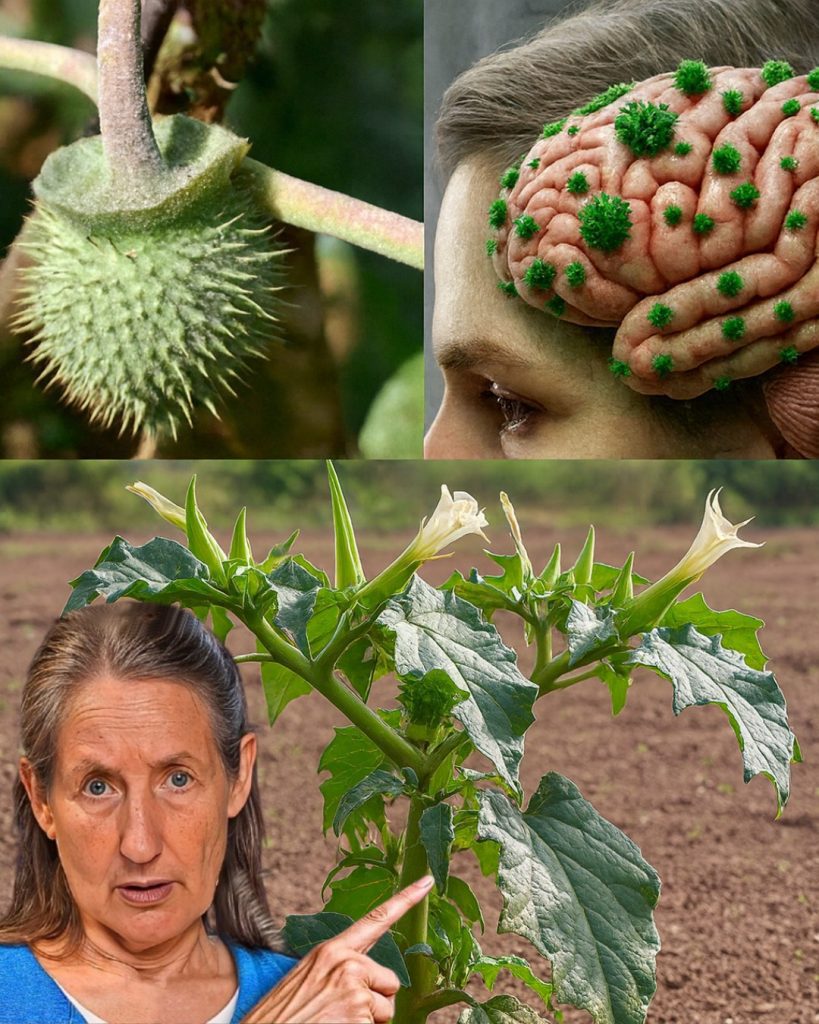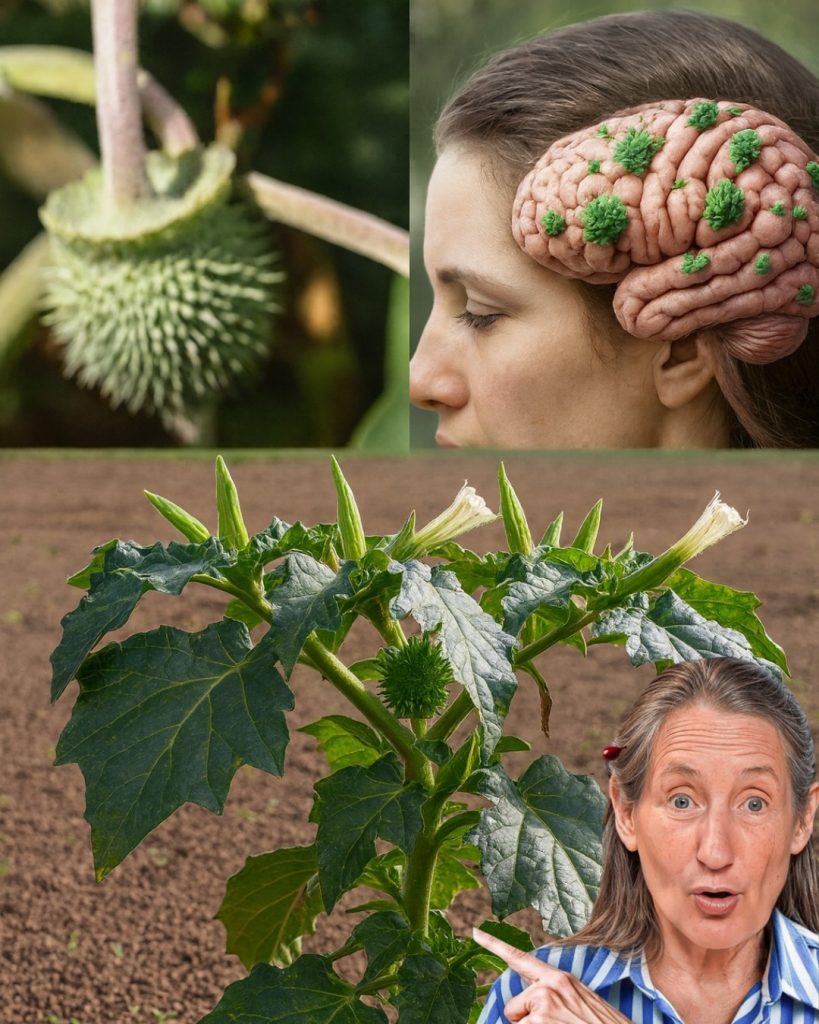Imagine stumbling upon a plant so breathtakingly beautiful that it stops you in your tracks. Its large, trumpet-shaped flowers glow under the moonlight, releasing a sweet, intoxicating fragrance that beckons you closer. This is Datura, a plant that grows wild in fields, roadsides, and even your own backyard. But beneath its stunning exterior lies a dark secret: Datura is one of nature’s most potent poisons, capable of enchanting and endangering anyone who dares to get too close. Dive into the captivating world of this mysterious plant, and uncover why its beauty comes with a warning.

🌸 A Plant of Mesmerizing Beauty
Datura, often called Jimsonweed, Thornapple, or Moonflower, belongs to the Solanaceae family, sharing lineage with tomatoes and belladonna. Its allure is undeniable. The plant boasts large, velvety leaves and striking flowers in shades of white, purple, or yellow that unfurl at night, earning it the name “Moonflower.” These blooms, which can span up to 8 inches, release a fragrance so enchanting it attracts nocturnal moths, creating a magical nighttime display.
But it’s not just the flowers that captivate. Datura’s spiky seed pods, aptly named “thornapples,” burst open to reveal hundreds of seeds, each capable of lying dormant in the soil for years before springing to life. This plant’s ability to thrive in diverse environments—from the arid deserts of Arizona to the humid landscapes of Florida—makes it a common sight worldwide. Its resilience and beauty make it a favorite for gardeners, but its charm comes with a chilling catch.
☠️ The Hidden Danger: A Toxic Temptation
Beneath Datura’s captivating exterior lies a deadly truth. Every part of this plant—leaves, flowers, seeds, and roots—is laced with potent tropane alkaloids, including atropine, scopolamine, and hyoscyamine. These compounds are responsible for Datura’s infamous psychoactive effects, which have fascinated and frightened humanity for centuries. A single misstep in handling or ingesting Datura can lead to severe consequences, from hallucinations and delirium to seizures, coma, or even death.
The symptoms of Datura poisoning are as unsettling as they are swift. Within minutes, a person may experience dry mouth, dilated pupils, rapid heartbeat, and confusion. In severe cases, vivid hallucinations and memory loss can leave victims in a disoriented haze, unable to distinguish reality from illusion. The plant’s toxicity is so potent that even brushing against its sap can cause skin irritation for some. This is no ordinary garden plant—it’s a botanical paradox, both breathtaking and life-threatening.
🕉️ A Storied Past: Sacred and Feared
Datura’s allure extends far beyond its physical beauty, weaving itself into the tapestry of human history. For centuries, indigenous cultures in the Americas, including the Navajo and Cherokee, revered Datura as a sacred plant. Shamans used it in rituals to induce visions, believing it connected them to the spiritual realm. In ancient India, it was associated with Lord Shiva, playing a role in religious ceremonies. Even in medieval Europe, Datura was whispered about in tales of witchcraft, love potions, and poisonings.
Yet, its sacred status came with caution. Ancient texts warned of its dangers, and folklore painted it as a plant of both magic and malevolence. Datura’s dual nature—revered as a gateway to the divine and feared as a harbinger of death—has cemented its place as one of nature’s most enigmatic creations. Its historical significance adds a layer of intrigue, making it impossible to dismiss as just another plant.
🌱 Growing Datura: A Dance with Danger
Despite its risks, Datura’s beauty makes it a tempting addition to gardens. The plant is surprisingly low-maintenance, thriving in full sun and well-drained soil. It’s drought-tolerant and can grow in poor conditions, making it ideal for bold garden displays. Whether you’re planting it as a specimen or a statement piece, Datura’s rapid growth—reaching up to 6 feet in a single season—ensures it commands attention.
To grow Datura from seed, start in early spring. Soak the seeds in warm water for 24 hours to boost germination, then plant them in a well-draining mix of peat and sand. Keep the soil moist but not waterlogged, and place the seedlings in a sunny spot. Once established, Datura requires regular watering during the growing season and a balanced fertilizer every two weeks to support its vigorous growth. Pruning at the end of the season encourages a bushier habit, while overwintering indoors protects it in colder climates.
But caution is key. Always wear gloves when handling Datura to avoid skin irritation, and keep it far from children and pets who might be drawn to its alluring flowers or spiky pods. Responsible cultivation ensures you can enjoy its beauty without falling victim to its darker side.
💊 Medicinal Marvel or Reckless Risk?
Datura’s alkaloids have long piqued the interest of pharmacologists. In controlled settings, compounds like atropine and scopolamine have been used to treat conditions such as motion sickness, muscle spasms, and even Parkinson’s disease. Traditional medicine has employed Datura for asthma relief, pain management, and inflammation, with Ayurvedic practices citing its use for wounds, ulcers, and respiratory issues.
However, these benefits come with a steep price. The line between a therapeutic dose and a toxic one is razor-thin, and improper use can lead to catastrophic outcomes. Modern pharmacology has largely replaced Datura with safer alternatives, but its potential continues to spark curiosity among researchers. The plant’s ability to heal and harm simultaneously underscores its complex nature, making it a subject of ongoing study.

🐞 Pests, Diseases, and Environmental Impact
Datura isn’t without its vulnerabilities. Common garden pests like aphids, spider mites, and whiteflies can target its lush foliage. Regular inspections and treatments, such as horticultural oils or a strong water spray, can keep infestations at bay. Fungal diseases like leaf spot and root rot may also strike, particularly in overly wet conditions. Good air circulation and careful watering practices are essential to prevent these issues.
In some regions, Datura’s adaptability makes it invasive, outcompeting native plants and disrupting ecosystems. Yet, it also serves a purpose, providing habitat for pollinators like moths and even showing potential in phytoremediation, where its robust nature helps remove contaminants from soil. This duality—both a threat and an asset—mirrors Datura’s broader narrative.
⚠️ Safety First: Respecting Datura’s Power
The key to appreciating Datura lies in respecting its potency. Never ingest any part of the plant, as even small amounts can be deadly. If accidental exposure occurs, seek immediate medical attention. Dispose of plant waste carefully, and educate others about its risks. By approaching Datura with caution, you can admire its beauty without falling prey to its dangers.
🌟 Why Datura Captivates Us
Datura is more than a plant—it’s a paradox, a living testament to nature’s ability to blend beauty with danger. Its glowing flowers, rich history, and potent properties make it a subject of endless fascination. Whether you’re a gardener, a historian, or simply curious, Datura invites you to explore its world with awe and caution. Its story reminds us that even the most stunning creations can hide secrets that demand respect.
So, the next time you spot those trumpet-shaped blooms glowing in the twilight, pause and admire—but keep your distance. Datura’s beauty is meant to be seen, not touched, and its dark secret is a reminder of nature’s complex balance. Let this enigmatic plant captivate your imagination, but always tread carefully in its presence.









